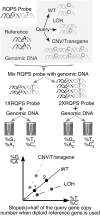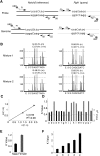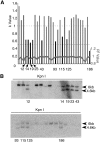Rapid identification of homologous recombinants and determination of gene copy number with reference/query pyrosequencing (RQPS)
- PMID: 19797679
- PMCID: PMC2775603
- DOI: 10.1101/gr.093856.109
Rapid identification of homologous recombinants and determination of gene copy number with reference/query pyrosequencing (RQPS)
Abstract
Manipulating the mouse genome is a widespread technology with important applications in many biological fields ranging from cancer research to developmental biology. Likewise, correlations between copy number variations (CNVs) and human diseases are emerging. We have developed the reference-query pyrosequencing (RQPS) method, which is based on quantitative pyrosequencing and uniquely designed probes containing single nucleotide variations (SNVs), to offer a simple and affordable genotyping solution capable of identifying homologous recombinants independent of the homology arm size, determining the micro-amplification status of endogenous human loci, and quantifying virus/transgene copy number in experimental or commercial species. In addition, we also present a simple pyrosequencing-based protocol that could be used for the enrichment of homologous recombinant embryonic stem (ES) cells.
Figures





Similar articles
-
Simple copy number determination with reference query pyrosequencing (RQPS).Cold Spring Harb Protoc. 2010 Sep 1;2010(9):pdb.prot5491. doi: 10.1101/pdb.prot5491. Cold Spring Harb Protoc. 2010. PMID: 20810638
-
Single-copy transgenic mice with chosen-site integration.Proc Natl Acad Sci U S A. 1996 Aug 20;93(17):9067-72. doi: 10.1073/pnas.93.17.9067. Proc Natl Acad Sci U S A. 1996. PMID: 8799155 Free PMC article.
-
Generation of single-copy transgenic mouse embryos directly from ES cells by tetraploid embryo complementation.BMC Biotechnol. 2001;1:12. doi: 10.1186/1472-6750-1-12. Epub 2001 Dec 18. BMC Biotechnol. 2001. PMID: 11782291 Free PMC article.
-
Recent advances in array comparative genomic hybridization technologies and their applications in human genetics.Eur J Hum Genet. 2006 Feb;14(2):139-48. doi: 10.1038/sj.ejhg.5201531. Eur J Hum Genet. 2006. PMID: 16288307 Review.
-
Methods to detect and analyze copy number variations at the genome-wide and locus-specific levels.Cytogenet Genome Res. 2008;123(1-4):333-42. doi: 10.1159/000184725. Epub 2009 Mar 11. Cytogenet Genome Res. 2008. PMID: 19287172 Review.
Cited by
-
Perivascular cells support folliculogenesis in the developing ovary.Proc Natl Acad Sci U S A. 2022 Oct 11;119(41):e2213026119. doi: 10.1073/pnas.2213026119. Epub 2022 Oct 4. Proc Natl Acad Sci U S A. 2022. PMID: 36194632 Free PMC article.
-
Notch1 loss of heterozygosity causes vascular tumors and lethal hemorrhage in mice.J Clin Invest. 2011 Feb;121(2):800-8. doi: 10.1172/JCI43114. Epub 2011 Jan 25. J Clin Invest. 2011. PMID: 21266774 Free PMC article.
-
Second-generation Notch1 activity-trap mouse line (N1IP::CreHI) provides a more comprehensive map of cells experiencing Notch1 activity.Development. 2015 Mar 15;142(6):1193-202. doi: 10.1242/dev.119529. Epub 2015 Feb 27. Development. 2015. PMID: 25725069 Free PMC article.
-
Quantitative Measurement of PARD3 Copy Number Variations in Human Neural Tube Defects.Cell Mol Neurobiol. 2018 Apr;38(3):605-614. doi: 10.1007/s10571-017-0506-0. Epub 2017 Jun 16. Cell Mol Neurobiol. 2018. PMID: 28623428 Free PMC article.
-
A perivascular niche for multipotent progenitors in the fetal testis.Nat Commun. 2018 Oct 30;9(1):4519. doi: 10.1038/s41467-018-06996-3. Nat Commun. 2018. PMID: 30375389 Free PMC article.
References
-
- Aitman TJ, Dong R, Vyse TJ, Norsworthy PJ, Johnson MD, Smith J, Mangion J, Roberton-Lowe C, Marshall AJ, Petretto E, et al. Copy number polymorphism in Fcgr3 predisposes to glomerulonephritis in rats and humans. Nature. 2006;439:851–855. - PubMed
-
- Aten E, White SJ, Kalf ME, Vossen RH, Thygesen HH, Ruivenkamp CA, Kriek M, Breuning MH, den Dunnen JT. Methods to detect CNVs in the human genome. Cytogenet Genome Res. 2008;123:313–321. - PubMed
Publication types
MeSH terms
Substances
Grants and funding
LinkOut - more resources
Full Text Sources
Other Literature Sources
Molecular Biology Databases
Research Materials
